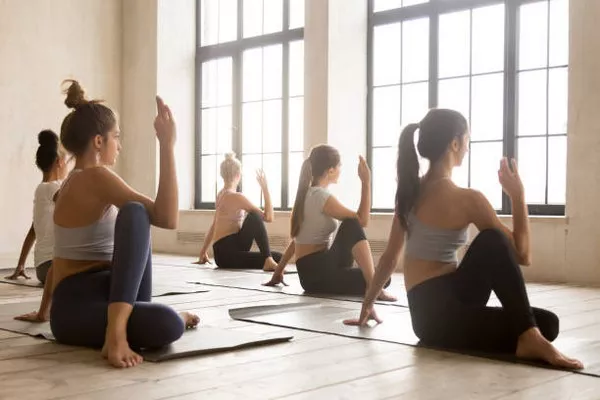Vinyasa Flow Yoga, a dynamic and breath-focused practice, combines a series of flowing postures that create a harmonious and invigorating sequence. This article delves into the best Vinyasa Flow sequences, exploring their benefits, variations, and step-by-step guides to help practitioners, from beginners to advanced, optimize their yoga routine.
What is Vinyasa Flow Yoga?
Vinyasa Flow Yoga, often referred to as simply Vinyasa or Flow Yoga, is a style of yoga characterized by stringing postures together so that you move seamlessly from one to another using breath. This style is sometimes also called “Vinyasa Flow” because of the smooth way that the poses run together and become like a dance.
The Core Elements of Vinyasa Flow
Breath Synchronization: Movement is linked to the breath, with each pose typically initiated by an inhalation or an exhalation.
Flowing Movements: Poses are performed in a continuous, smooth flow.
Variety: Sequences are often varied, with no two classes being exactly alike.
Benefits of Vinyasa Flow Yoga
Improves Cardiovascular Health: The continuous flow increases the heart rate.
Enhances Flexibility and Strength: Dynamic movements stretch and strengthen muscles.
Promotes Mindfulness: Breath-focused movements cultivate a meditative state.
Increases Energy Levels: Flow sequences stimulate the body and mind, boosting energy.
Reduces Stress: The combination of physical activity and mindful breathing helps reduce stress and anxiety.
Creating the Best Vinyasa Flow Sequence
Designing a Vinyasa Flow sequence involves understanding the balance between warming up the body, challenging the muscles, and allowing time for relaxation. Here is a step-by-step guide to creating a balanced and effective Vinyasa Flow sequence:
Warm-Up (10-15 minutes)
Child’s Pose (Balasana): Start with a few deep breaths to center the mind.
Cat-Cow Pose (Marjaryasana-Bitilasana): Warm up the spine and connect movement with breath.
Downward-Facing Dog (Adho Mukha Svanasana): Stretch the hamstrings, calves, and shoulders.
Forward Fold (Uttanasana): Release tension in the back and hamstrings.
Sun Salutations (15-20 minutes)
Sun Salutation A (Surya Namaskar A)
Mountain Pose (Tadasana): Begin with a grounding pose.
Inhale – Upward Salute (Urdhva Hastasana): Stretch arms overhead.
Exhale – Forward Fold (Uttanasana): Fold forward, releasing the back.
Inhale – Half Lift (Ardha Uttanasana): Lengthen the spine.
Exhale – Plank Pose (Phalakasana): Step back into a plank.
Exhale – Chaturanga Dandasana: Lower halfway down.
Inhale – Upward-Facing Dog (Urdhva Mukha Svanasana): Open the chest.
Exhale – Downward-Facing Dog (Adho Mukha Svanasana): Hold for five breaths.
Inhale – Step Forward to Half Lift (Ardha Uttanasana)
Exhale – Forward Fold (Uttanasana)
Inhale – Upward Salute (Urdhva Hastasana)
Exhale – Mountain Pose (Tadasana)
Repeat Sun Salutation A three to five times.
Standing Sequences (20-25 minutes)
Sequence 1: Warrior Flow
Warrior I (Virabhadrasana I)
Warrior II (Virabhadrasana II)
Reverse Warrior (Viparita Virabhadrasana)
Extended Side Angle (Utthita Parsvakonasana)
Triangle Pose (Trikonasana)
Sequence 2: Balance and Strength
Chair Pose (Utkatasana)
Eagle Pose (Garudasana)
Tree Pose (Vrksasana)
Warrior III (Virabhadrasana III)
Half Moon Pose (Ardha Chandrasana)
Seated and Supine Poses (15-20 minutes)
Seated Forward Fold (Paschimottanasana)
Bound Angle Pose (Baddha Konasana)
Bridge Pose (Setu Bandhasana)
Reclining Pigeon Pose (Supta Kapotasana)
Happy Baby Pose (Ananda Balasana)
Cool Down and Savasana (10-15 minutes)
Supine Twist (Supta Matsyendrasana)
Legs-Up-The-Wall Pose (Viparita Karani)
Corpse Pose (Savasana): Rest for 5-10 minutes, focusing on breath and relaxation.
See Also: Can You Lose Weight With Vinyasa Yoga
Advanced Vinyasa Flow Sequences
For experienced practitioners, adding more challenging poses can enhance the practice.
Arm Balances and Inversions
Crow Pose (Bakasana)
Side Crow Pose (Parsva Bakasana)
Headstand (Sirsasana)
Forearm Stand (Pincha Mayurasana)
Handstand (Adho Mukha Vrksasana)
Backbends
Camel Pose (Ustrasana)
Bow Pose (Dhanurasana)
Wheel Pose (Urdhva Dhanurasana)
King Pigeon Pose (Eka Pada Rajakapotasana)
Tips for Practicing Vinyasa Flow Yoga
Focus on Breath: Synchronize movements with breath for a seamless flow.
Listen to Your Body: Modify poses as needed to avoid injury.
Use Props: Blocks, straps, and blankets can enhance your practice.
Stay Hydrated: Drink water before and after your practice.
Practice Consistently: Regular practice improves strength, flexibility, and mindfulness.
Common Mistakes and How to Avoid Them
Skipping Warm-Up: Always start with gentle warm-up poses to prepare the body.
Rushing Through Poses: Move mindfully and avoid rushing from one pose to another.
Ignoring Alignment: Proper alignment prevents injuries and maximizes benefits.
Holding Breath: Keep the breath steady and even throughout the practice.
Overstretching: Respect your limits to prevent strains and injuries.
Conclusion
Vinyasa Flow Yoga is a versatile and invigorating practice that offers numerous physical and mental benefits. By following a well-rounded sequence, focusing on breath, and practicing consistently, you can enhance your overall well-being. Whether you are a beginner or an advanced yogi, incorporating the best Vinyasa Flow sequences into your routine will help you achieve a balanced, strong, and mindful practice.


